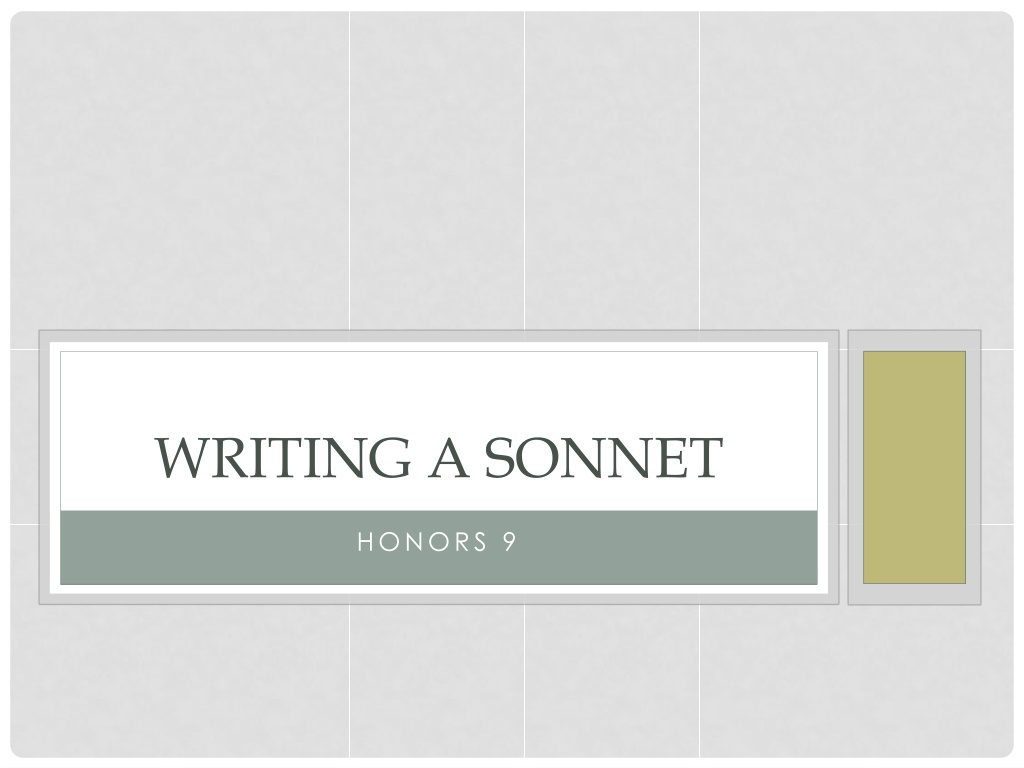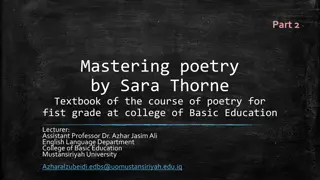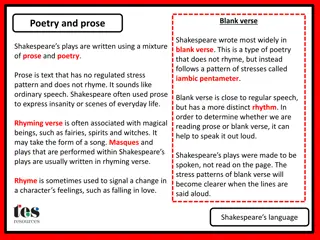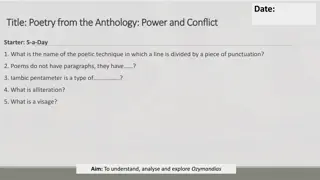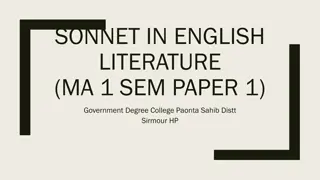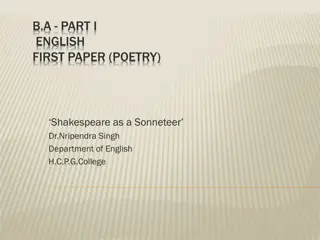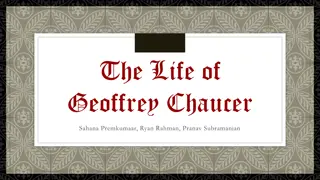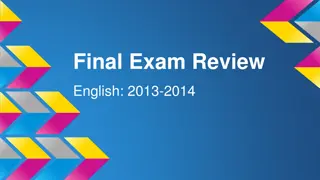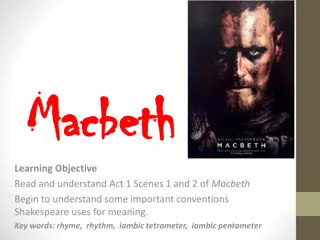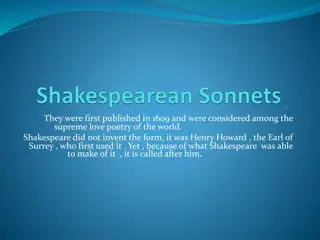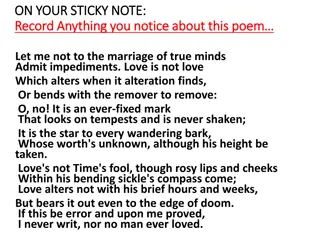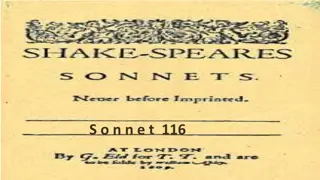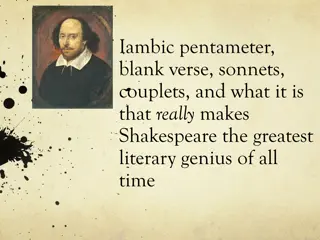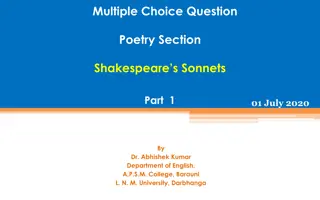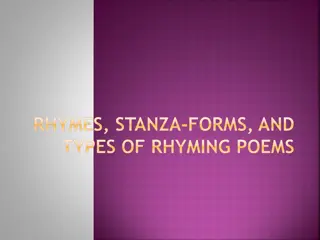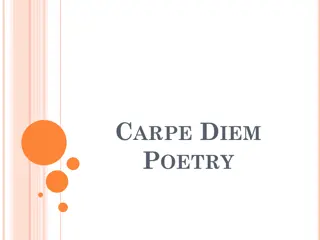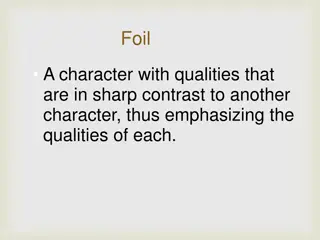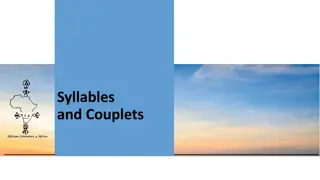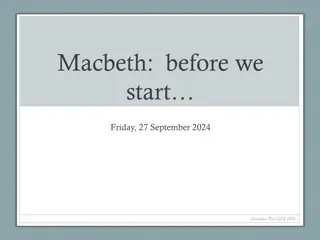Exploring the Art of Writing Sonnets and Understanding Iambic Pentameter
Uncover the beauty of sonnets and the significance of iambic pentameter in poetic works. Dive into the rhythmic structure, syllables, and poetic meter, discovering the allure and impact of writing in iambic pentameter alongside exploring the phonological intricacies of syllables.
Download Presentation

Please find below an Image/Link to download the presentation.
The content on the website is provided AS IS for your information and personal use only. It may not be sold, licensed, or shared on other websites without obtaining consent from the author. Download presentation by click this link. If you encounter any issues during the download, it is possible that the publisher has removed the file from their server.
E N D
Presentation Transcript
WRITING A SONNET HONORS 9
WHAT IS A SONNET? A sonnet is a fourteen-line poem in iambic pentameter. Iambic what????
IAMBIC PENTAMETER Iambic Pentameter is the rhythm and meter in which poets and playwrights wrote in Elizabethan England. It is a meter that Shakespeare uses.
HEARTBEAT Quite simply, it sounds like this: deeDUM, deeDUM, deeDUM, deeDUM,deeDUM It consists of a line of five iambic feet, ten syllables with five unstressed and five stressed syllables. It is the first and last sound we ever hear, it is the rhythm of the human heart beat.
PENTAMETER? Well an iamb is dee Dum it is the heart beat. Penta is a Greek number prefix meaning 5. Meter refers to the pattern (structure) So, there are five iambs per line! (Iambic penta meter )
WHY WRITE IN IAMBIC PENTAMETER? It is percussive and attractive to the ear and has an effect on the listener's central nervous system. An Example of Pentameter from Shakespeare: but SOFT what LIGHT through YONder WINdow BREAKS
ANALYZING STRUCTURE: SYLLABLES What is a syllable? A syllable is a unit of organization for a sequence of speech sounds. For example, the word water is composed of two syllables: wa and ter. A syllable is typically made up of a syllable nucleus (most often a vowel) with optional initial and final margins (typically, consonants).
SYLLABLES Syllables are often considered the phonological "building blocks" of words. They can influence the rhythm of a language, its poetic meter, and its stress patterns. How many syllables are in (please raise your hand if you know) : Supercalifragilisticexpialidocious
YOU TRY Copy the sentence below on your notes beside YOU TRY and write the number of syllables beside the last quotation mark: But soft, what light through yonder window breaks.
STRESSED VS. UNSTRESSED Looking at the same sentence that you just wrote down, please underline the stressed words/syllables. Think of the heartbeat deeDUM (DUM=stressed) But soft, what light through yonder window breaks.
RHYTHM? Underneath your underlined sentence write the rhythmic pattern that this line was written in: But soft, what light through yonder window breaks.
LETS SOLIDIFY THIS INFORMATION WITH A CLIP! https://www.youtube.com/watch?v=v0aAWuUX5jU
POETIC STRUCTURE Along with this rhythmic pattern, sonnets also follow: a specific poetic structure a rhyming pattern Structure Rhyming With what I gave up to get was bittersweet It was like winning a huge meet Ironic 'cause I think I'm getting so huge I need a shrink I'm beginning to lose sleep: one sheep, two sheep Going cucko and cuckier as Kool Keith But I'm actually weirder than you think Cause I'm...
RHYMING PATTERNS The Shakespearean sonnet has three quatrains followed by a couplet, the scheme being: abab cdcd efef gg. Huh?
QUATRAINS Quatrains are four line stanzas of any kind I have divided the following sonnet into the three quatrains. (You will also see the rhyming pattern marked out for you)
SONNET 116 Let me not to the marriage of true minds (a) Admit impediments. Love is not love (b) Which alters when it alteration finds,(a) Or bends with the remover to remove:(b) O, no! it is an ever-fixed mark,(c) That looks on tempests and is never shaken;(d) It is the star to every wandering bark,(c) Whose worth's unknown, although his height be taken.(d) Love's not Time's fool, though rosy lips and cheeks(e) Within his bending sickle's compass come;(f) Love alters not with his brief hours and weeks,(e) But bears it out even to the edge of doom.(f) If this be error and upon me proved,(g) I never writ, nor no man ever loved.(g)
TRANSLATION Let me not declare any reasons why two True-minded people should not be married. Love is not love Which changes when it finds a change in circumstances, Or bends from its firm stand even when a lover is unfaithful: Oh no! it is a lighthouse That sees storms but it never shaken; Love is the guiding north star to every lost ship, Whose value cannot be calculated, although its altitude can be measured. Love is not at the mercy of Time, though physical beauty Comes within the compass of his sickle. Love does not alter with hours and weeks, But, rather, it endures until the last day of life. If I am proved wrong about these thoughts on love Then I recant all that I have written, and no man has ever [truly] loved.
A BIT MORE ON SONNETS TO IMPRESS YOUR FRIENDS Shakespeare is not the only poet that gained fame for writing sonnets Sonnets follow a predetermined rhyme scheme; the rhyme pattern determines if the sonnet is Petrarchan (Italian), or Shakespearean.
HISTORY OF THE SONNET The sonnet began in Italy, where the poet Francesco Petrarch first established it as a serious form of poetry. Petrarch wrote a large collection of sonnets addressed to a young woman named Laura he saw one afternoon at church. She was not interested, but he didn t let that stop him, and proceeded to publish some 260 sonnets about her followed by another hundred or so after her death. Petrarch is, quite possibly, the first recorded literary stalker.
SHAKESPEAREAN SONNET FORM FOR NOTES Add this to your notes under Shakespearean Sonnet Form
THE TURN A sonnet s turn is the point in the sonnet where the poet changes perspective or alters his/her approach to description. This often results in a sonnet following a position- contrasting position type of structure, or occasionally a change of heart in the poet at the end of the verse.
WE WILL FOCUS ON THE SHAKESPEAREAN SONNET: PROBLEM AND SOLUTION Shakespearean Sonnet Theme Pattern: 1. The first quatrain introduces the subject (the speaker's loneliness and depression). 2. The second quatrain develops the subject further and even introduces more conflict (the speaker gets super-elaborate about why he feels so down in the dumps).
PROBLEM AND SOLUTION 3. The third quatrain offers a solution to the speaker's problem (he remembers that someone out there really loves him and it's enough to bring him out of his depression). 4. Finally, the couplet offers up a pretty strong conclusion and solution to the original problem (as long as the speaker is loved, it doesn't matter how screwed up the rest of his life is).
SUMMARY OF ALL OF THIS IN A CLIP! https://www.youtube.com/watch?v=NN3ypMK9lyg
